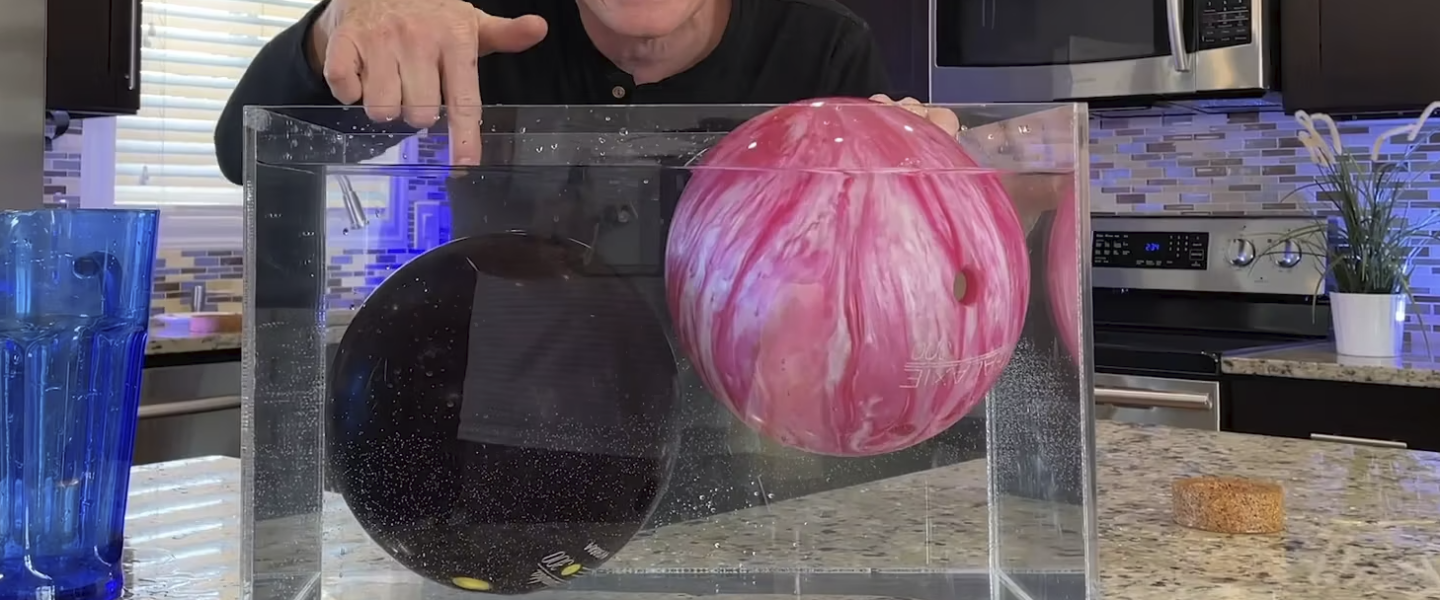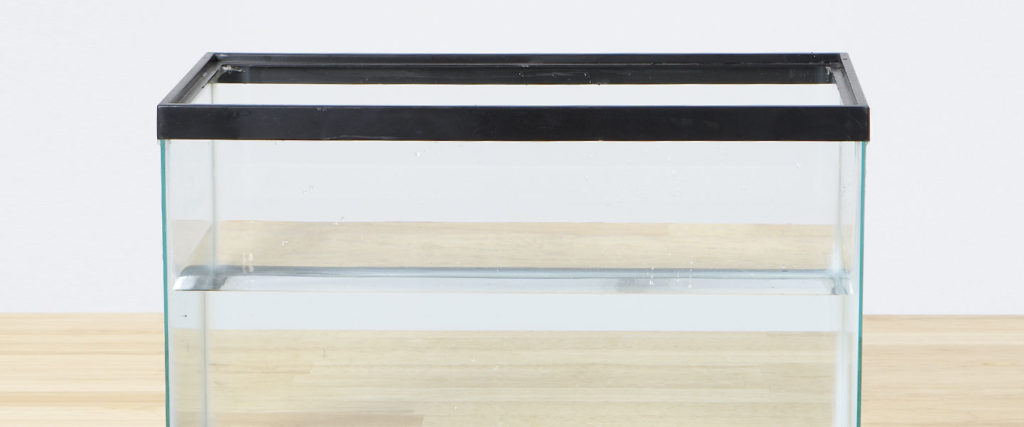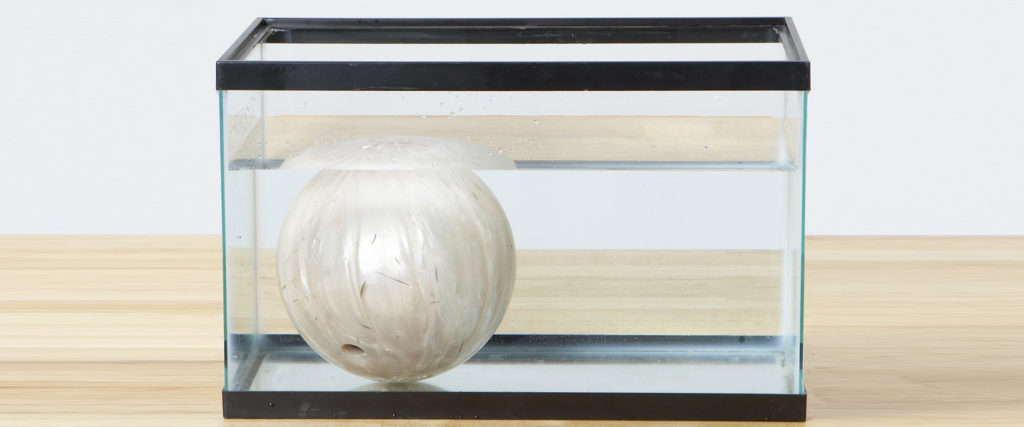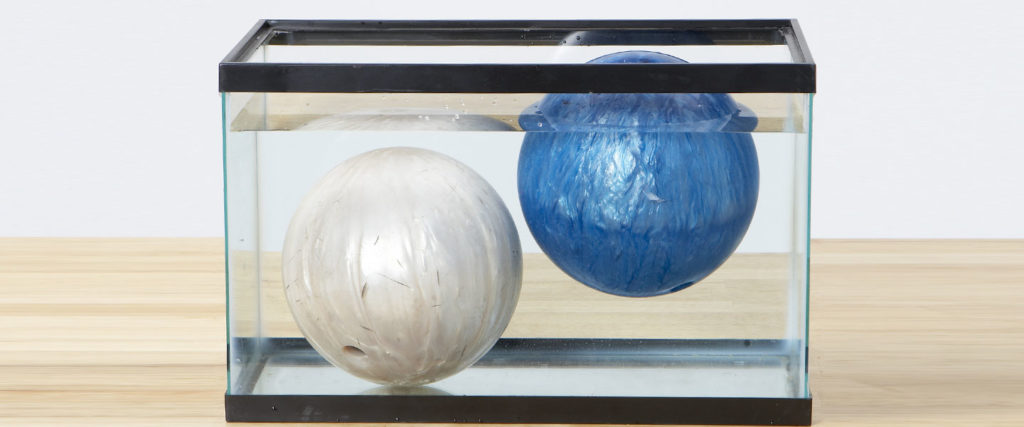Seven-Layer Density Column
What if you could stack seven different liquids in seven different layers?

We all know that certain things float in water while other things sink, but why? Do all heavy things sink? Why does a penny sink and an aircraft carrier float? Think you know the answers? Well, get ready for a few amazing surprises.

Fill the aquarium three-fourths full with water.

Carefully place (do not drop) one bowling ball in the water. Does it float or sink? Repeat this experiment, noting the weight of each bowling ball, until every ball has taken the plunge.

What did you discover? It seems that anything heavier than 12 pounds sinks, but bowling balls less than 12 pounds float. Amazing!
Note: It’s important that we work in metric units as we make the necessary density calculations to fully understand the science. Pull out your calculators and sharpen up your math skills.
If you’ve ever been bowling, you know that bowling balls range from about 8 to 16 pounds. However, did you know that all regulation bowling balls are the same size? According to official bowling rules from the Professional Bowlers Association,
The circumference of a ball shall not be more than 27.002 inches nor less than 26.704 inches, nor shall it weigh more than 16 pounds (no minimum weight).
You could measure the circumference of each of your bowling balls by wrapping a piece of string around the ball at its widest part and marking the circumference on the string. Based on what we know from the Professional Bowlers Association, your measurement should be 27 inches, so that’s the number we’ll use for all of our calculations.
Since we’re doing science, it’s necessary to convert inches to centimeters using the conversion factor of 1 inch = 2.54 centimeters (cm).
So, the circumference of the bowling ball in centimeters is:
27 inches × 2.54 cm/inch = 68.58 cm
Next, we need to find the radius of the bowling ball. Again, you could use a string and a ruler to make your measurement, or you can use the formula for finding the circumference of a sphere to determine the radius. Remember that π = 3.14. Here’s the formula:
circumference = 2 × π × radius
You know the circumference is 68.58 cm, so solving the equation for the radius you’ll arrive at 10.92 cm.
Now that you know the radius, you can determine the volume using this equation:
volume = 4/3 × π × radius3
volume = 4/3 × 3.14 × (10.92 cm)3
volume = 5,451.75 cubic centimeters (cm3)
Of course, the keen observer will never fail to point out the fact that there are holes in the bowling ball for your fingers. Again, you could jump through some hoops to determine the volume of the holes, but it’s fair to say the holes do not affect the overall density of the bowling balls enough to change the demonstration. So, we’ll go with the magic number of 5,452 cm3 (yes, we rounded up to simplify the calculations).
As soon as you know the volume of the bowling ball, you can easily calculate the ball’s density by dividing the weight of the ball (in grams) by the volume (5,452 cm3).
To convert the weight of the ball from pounds to grams, use the conversion of 1 pound = 453.6 grams (but we’ll round up to 454 grams). Here’s a table with the converted weights of bowling balls.
|
BOWLING BALL |
CONVERTED TO GRAMS |
| 8 pounds | 3,632 grams |
| 9 pounds | 4,086 grams |
| 10 pounds | 4,540 grams |
| 11 pounds | 4,994 grams |
| 12 pounds | 5,448 grams |
| 13 pounds | 5,902 grams |
| 14 pounds | 6,356 grams |
| 15 pounds | 6,810 grams |
| 16 pounds | 7,264 grams |
Now it’s easy to calculate the density of each of these bowling balls. Simply divide the weight of the ball in grams by the volume of the ball in cubic centimeters. For example, here’s how to calculate the density of an 8-pound (3,632 g) bowling ball.
density = mass / volume
density = 3,632 grams / 5,452 cm3 = 0.67 g/cm3
It’s no wonder that an 8-pound bowling ball easily floats in water. The density of water is 1.0 g/cm3 so the 8-pound bowling ball floats because it is less dense than the water (.67 < 1.0).
The chart below shows the calculated density of each size bowling ball, and you can see at what weight the bowling balls begin to sink (their density is greater than that of water at 1.0 g/cm3).
|
BOWLING BALL |
CONVERTED FROM POUNDS TO GRAMS |
DENSITY WEIGHT /5,452 CM3 |
| 8 pounds | 3,632 grams | 0.67 g/cm3 |
| 9 pounds | 4,086 grams | 0.75 g/cm3 |
| 10 pounds | 4,540 grams | 0.83 g/cm3 |
| 11 pounds | 4,994 grams | 0.92 g/cm3 |
| 12 pounds | 5,448 grams | 0.99 g/cm3 |
| 13 pounds | 5,902 grams | 1.08 g/cm3 |
| 14 pounds | 6,356 grams | 1.17 g/cm3 |
| 15 pounds | 6,810 grams | 1.25 g/cm3 |
| 16 pounds | 7,264 grams | 1.33 g/cm3 |
If the calculation is correct, a 12-pound bowling ball should just barely float in the water-filled aquarium.
If I lost you somewhere in the midst of all of these numbers, here’s the synopsis. Any bowling ball that weighs more than 12 pounds will sink in water, and any bowling ball that weighs less than 12 pounds will float. If that wasn’t enough, there’s something else to consider. Archimedes’ Principle states that the buoyant force exerted on a fluid is equal to the weight of the fluid displaced. So, when an object is placed in water, it will displace its weight in water. The 8-pound ball displaces 8 pounds of water. However, the ball also takes up more volume than 8 pounds of water, so it floats.
The same principle explains why an aircraft carrier floats even though it’s made of steel. If you consider that steel has a density of 7.8 g/cm3, shouldn’t the aircraft carrier sink? The ability of the ship to float is not entirely based on the material from which it is made. A ship is built in such a way that it encloses large amounts of open space, and this contributes to its overall density. According to Archimedes, the ship displaces its weight in water, but because of the way the ship is constructed, it takes up more space than the volume of the water it displaces and it floats.
Don’t limit your curiosity to bowling balls alone. Try to float anything. Will a bottle of ketchup float or sink? Will a rubber chicken float or sink? How about an orange? Here’s something strange. An unpeeled orange floats but a peeled orange sinks. Hmm, any guesses? Tiny pockets of air are trapped in the orange rind, making the unpeeled orange float in water. (These pockets of air work like “floaties” and decrease the density of the orange so that it floats in the water.)
This game is a great way for you to practice formulating a hypothesis, testing a theory, and using what you know (or don’t yet know) about density to determine why an object floats or sinks, just like a real scientist.